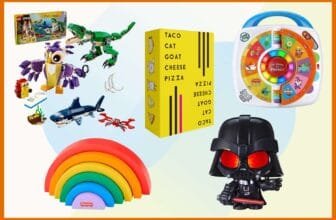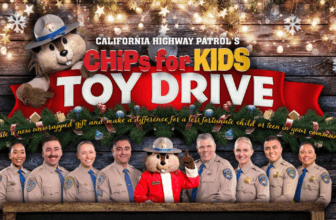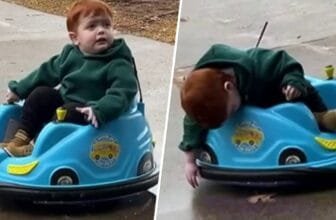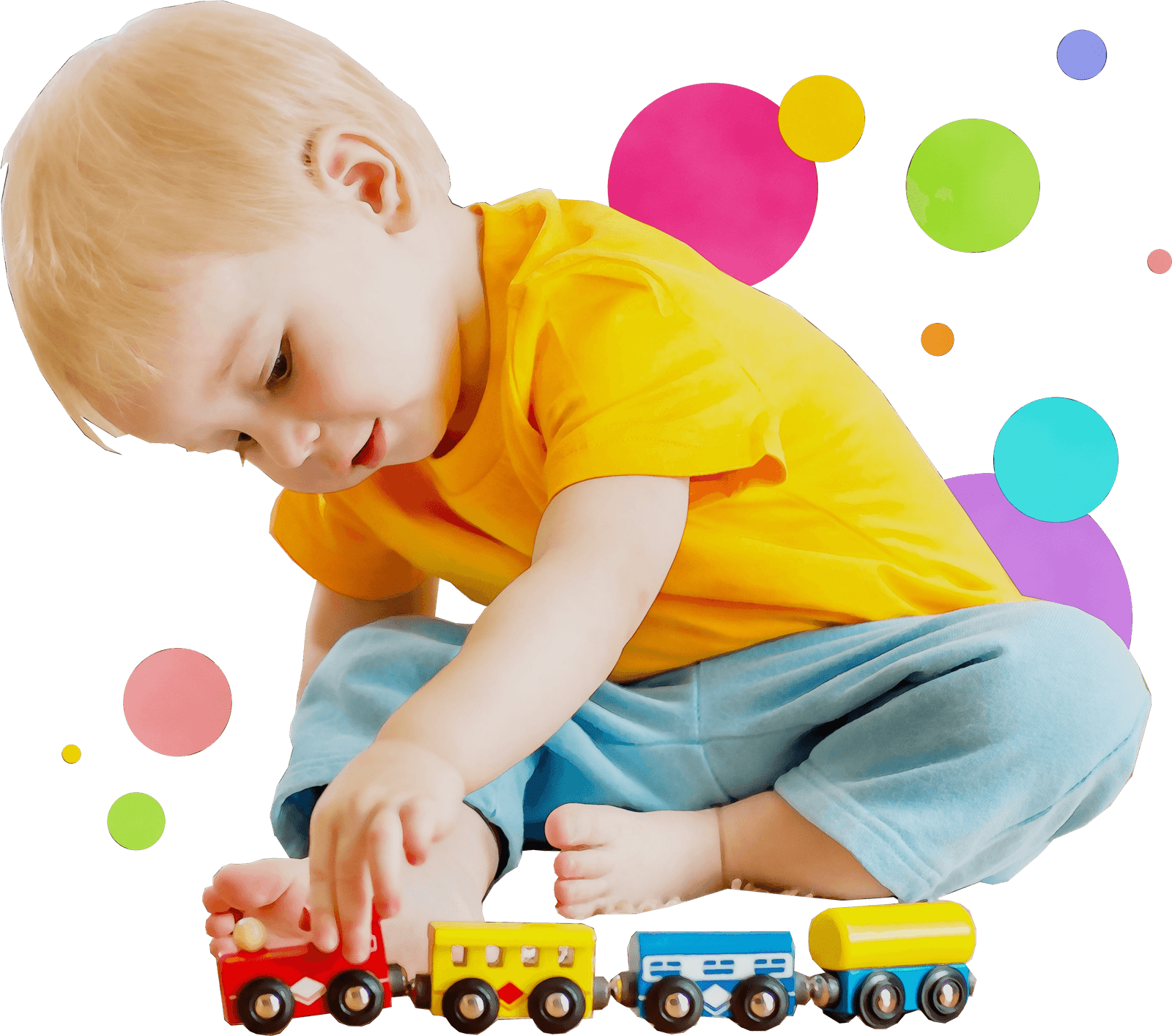
21 items in this article
9 items on sale!
Photo-Illustration: Courtesy of retailers
At 6 months old, babies can’t thank you for a well-considered gift, but they can make eye contact, grasp objects in their little hands, and smile back at you. Because they grow and learn through play, the best gifts for 6-month-olds will both nurture their development and keep them engaged. To narrow the market of baby toys, accessories, and books, and help guide you toward the very best baby gifts out there, I spoke to child-development experts, as well as parents, for their picks — and included a few personal picks, too.
While the experts agreed that the best thing for babies is adult interaction — talking, singing, and sensory play — toys can make those adult interactions more fun, and simple gifts that encourage sensory exploration, fine and gross motor skills, and cause and effect are best. Dr. Patricia Cantor, a retired professor of early-childhood education at Plymouth State University and the co-author of Techwise Infant and Toddler Teachers, gave us this easy rule of thumb: “You don’t want to get them something you turn on and they watch; you want to give them a toy they can do something with.” Read on for 21 gifts our experts say will make a not-quite-newborn very happy. And as a mom to a 2-year-old and a 5-year-old boy, I’ve tried some of these with my kids firsthand and added a few notes of my own. For gift ideas for all ages, head to the Strategist Toy Store, where you’ll find 100 of our favorite tried-and-true toys for all the children in your life. And for a breakdown of gifts for every age one through 12, head here.
Update on July 22, 2024: Updated prices and checked stock for all products.
Chances are the baby in your life already owns this light-up musical toy, but in case they don’t, you must get this for them. They’re so ubiquitous that I would put my money on the fact that it’s probably one of the best-selling baby toys ever invented. I got one as a gift when I was pregnant with my older son and had to get a new one for the baby because it had broken from so much use. Strategist senior editor Winnie Yang says that when her son was 6-month-old, he “screeched so hard for it, he loved it so much.” It plays ten classic masterpieces from Chopin to Mozart, while colorful lights flash along to the rhythm of each melody. Babies love the music and are absolutely mesmerized by the lights. I call it “baby TV” because both my kids would be entranced by it for minutes at a time.
At around 6 months, babies are beginning to move around on their own, and Alexandra Figueras-Daniel, an assistant research professor at the National Institute for Early Education Research, says a toy like this beet that plays beat-boxing music when it’s rolled is a great way to “encourage crawling and getting around.” When the baby pushes it, the beet’s pointed bottom makes it wobble and rock in an unpredictable path while producing fun beatbox riffs and rattle sounds that, Figueras-Daniel explains, “entice children to chase after it.”
Hillary Dixler, Eater’s restaurant editor, says that her daughter loved this light-up drum from Hape when she was around 6 months old (she still plays with it at age 2). It’s the perfect size for helping a little one practice sitting up. “She liked that you could lean forward onto it,” Dixler says. “Plus, that age was all about banging, and this drum rewards that banging with different drum tones and, when it inevitably falls over, different melodies.” Another feature Dixler appreciates is that the noises and drum music are actually cute. “I really can’t overstate how rare it is to find noise-making toys that don’t make you want to crawl out of your skin,” she says. “This one — even the drum melodies it plays on its side — truly are tolerable!” Plus, she adds, you can turn the volume down to medium.
Figueras-Daniel loves this wobbly little penguin for another cute way to experiment with cause and effect — and music. The toy stands back up after your little one bats at it, while a built-in bell makes a soothing, tinkling sound as it sways from side to side.
Books are always welcome gifts at any age, but three of our experts — Cantor, Klein, and MacLaughlin— all cited Baby Faces, by Margaret Miller, as their No. 1 recommendation for 6-month-olds. “Babies at 6 months start to be more inclined to pay attention to a book, and they’re starting to notice other babies’ faces. They really like to look at other babies,” says MacLaughlin. Klein further explains, saying, “The words are not the most important part. Looking at a picture and the interaction with the parent around the book gives the message that looking at books is a positive thing.”
Figueras-Daniel recommends books from a series called Indestructibles, which are durable books made with a material that’s rip- and water-proof. The books are also very flexible, which she says is great for 6-month-olds because they can actually flip through it and hold it in their hands. (The pages make for an excellent on-the-go teether as well.) This helps them to “learn to turn the pages, and that eventually develops into literacy skills,” which Figueras-Daniel says are important to start encouraging at an early age. “Sometimes we take for granted that those are skills that we learn: That we read from left to right, where the words on the page start, or where on the page words are even placed,” she adds. Strategist senior writer (and resident toy expert) Liza Corsillo is also a fan: “We have five of these books and they are always the first thing I pack in case our son gets fussy when we go out to the park or to brunch. He likes to chew it, fold it, shake it really hard, and even tries to turn the pages. He uses it like a noisemaker.”
At this age, babies will put everything in their mouth as a way to explore and soothe emerging teeth. Getting them a teether, like this bright, nubby silicone pacifier-shaped raspberry, would be a fun and functional gift. Every part of the raspberry, from the leaves to the handle to the fruit itself, is designed to help with the pain of incoming teeth. Mom of two Christine Lee says that when her younger kid was 6 months old, he would chomp on all of it. “It’s his favorite chew toy,” she says.
As basic as these stacking cups appear, they actually aid in the development of fine motor stills, which are still rudimentary at this age, according to Cantor. She and other child experts recommend stacking toys like this that babies can play and experiment with at six months and grow into later. Both Cantor and Dr. Tovah P. Klein, the director of the Barnard College Center for Toddler Development and author of How Toddlers Thrive, recommend getting something lightweight. I love these cups from Danish company Mushie, which come in an attractive set of neutral colors and are a little more exciting than those ubiquitous primary-colored ones. The bottoms of half of them have perforated designs, making them great for bath time, too.
For something slightly more challenging, consider this stack-and-sort toy from Fisher-Price. Corsillo, who is a fan of wooden toys for their durability and sustainable construction, calls out Fisher-Price’s line for its cute designs, affordable prices, and the fact that they look like they’d be able to endure a lot of rigorous play. She particularly likes this animal sorting-and-stacking set, which includes an alligator, lion, and koala that can be mixed and matched into various configurations in a baby version of the Exquisite Corpse game.
Cantor says that a mirror is also great for this age. “They like looking in the mirror — even if they have no clue it’s themselves.” Sarah MacLaughlin, a social worker and the author of What Not to Say: Tools for Talking With Young Children, seconds this idea, noting that a six-month-old can look at a self-standing mirror like this one during tummy time and also play with it while lying on their stomach. And it’s soft so they won’t hurt themselves on any sharp corners.
Part teether, stuffed animal, and sensory toy, Cantor told us that Taggies can help keep a 6-month-old occupied at home but while on the go, whether in a stroller or on a plane. “These have a fair amount of interesting stuff for babies to do,” she explains. “There are lots of tags all around the outside and different textures, like a plastic ring or crinkly fabric,” that’ll hold little ones’ attention.
It may sound simple, but MacLaughlin says a ball that a baby can pass back and forth with parents would make a good gift for a 6-month-old. “We know babies’ brains build through those back-and-forth interactions with a caregiving adult,” she explains. “We call it serve and return.” She adds that even if Mom or Dad does most of the passing, rolling the ball, coupled “with lots of eye contact and laughing, is good for their motor skills and social-emotional development as it draws the connection between the child and the adult.” Corsillo bought this ball in a bug print for her baby when he was a 6-month-old because she liked the pattern and, she says, the “very satisfying texture (classic playground-ball crosshatch) that I knew my son Arlo would appreciate.” They play with it in a number of ways: “I put it between his thighs while he sits up in front of me as a focal point to help him balance. I hit it like a drum (it has a nice deep sound) and invite him to do the same. And sometimes, I’ll put him in a carrier facing out and put the ball on a countertop across from his dad or grandparent and let him kick it.” Finally, the cute animal illustrations make for good baby-and-me conversation as well.
This teether is a little easier to hang on to, thanks to an interior grip. Strategist senior editor Simone Kitchens got it as a gift when her daughter was 3 months old. “She never took a pacifier (it always popped out), so this was great, especially in the car,” she says. “Now we keep it in the freezer and pull it out when she’s teething.”
Figueras-Daniel told us about these even more advanced stacking blocks, which come with little animals, which she calls an “all-time” favorite. She notes that they may be a little more challenging for a 6-month-old than the above styles (the manufacturer suggests them for 12-month-olds and up) but says looking ahead to the next developmental step is important in early child education. “It starts them working on some fine motor skills; as you stack the blocks, you can put the animals inside each one, so the toy has a double purpose,” she explains. “The little animals add another level of interest to the game.” Of course, knocking them over is just fine, as that teaches babies cause and effect, according to her. “Even though it may seem like a toy is slightly above something that they can do,” exposing them to it can help a 6-month-old get there.
This motor-skill-honing cube is a more flexible (and therefore perhaps easier) version of rigid shape sorters you’ll see populating toy guides for this age. (Figueras-Daniel calls it “almost like the precursor to a shape sorter.”) Instead of having hard edges, the box’s sides consist of elastic strings in various patterns that will challenge a 6-month-old to “put objects inside of it by kind of budging them through,” she explains, without frustrating them. Unlike other shape sorters, babies can also reach inside to pull the blocks out, making it much more interactive and rewarding for baby.
For another type of in-and-out toy, Figueras-Daniel also loves this little insect cage that comes with a plushy butterfly, ladybug, caterpillar, and cricket. The compact, eight-inch size and soft handle make it easy to bring along with you.
For the slightly more mobile baby, consider this roaming light-up bee toy that Strategist contributing editor Jessica Silvester bought for her 8-month-old after spotting it on Eva Chen’s baby list. Unlike the beet above, the bee moves around on its own. I got it for my younger son last Christmas when he was about 7 months old and just beginning to crawl. The bee, which is removable and doubles as a rattling wobble toy, sits on top of a cloud that moves in a circle or in a more random pattern, encouraging babies to go after it. It plays the cutest music that reminds me of the theme song from Super Mario, and it’s just so adorable to watch. Solomon went wild for this thing when he first got it.
To accompany the light-up drum, try these little egg-shaped shakers that fit perfectly into baby hands, helping them practice grasping and clutching skills while teaching cause and effect. Cantor recommends them, saying, “If they move their hand and this little egg shaker makes a noise, that’s going to get their attention, then over time, they’ll start to realize that their action is what’s causing the noise.”
MacLaughlin says that making a picture book by filling a soft album like this with photos of baby and family would make for a thoughtful gift that’s developmental. “They may not necessarily know that it’s them and not another baby but that doesn’t matter.” she explains, adding, “At this point, their vision is getting better so they’re becoming a lot more aware of the world around them.” In addition to being soft and flexible, this autumnal album has plastic sleeves to help protect photos from the baby’s drool (plus adorable forest-themed illustrations and characters).
If you’d rather take the guesswork out of gifting age-appropriate toys to the 6-month-old in your life, consider KiwiCo’s Panda Crate, a subscription service that sends out a box of toys tailored to their age every other month. Corsillo likes these boxes because “they are full of things I would be excited to get as a standalone toy,” she says. For example, the “Let’s Listen!” box geared toward 6- and 7-month-olds includes a piano xylophone and shakers for promoting motor skills and introducing sound and movement. Corsillo particularly likes the play scarves and wood scarf keeper, which are a variation on the ubiquitous play-tissue boxes found in other kits. “The keeper looks like a rabbit hutch and has beads you can move along each of the bars, so it incorporates more ways to play,” says Corsillo.
Another milestone for many 6-month-olds is beginning solid foods, an exciting and often nerve-racking event. But getting the right gear, like a high chair and safe, age-appropriate utensils, can make the transition smoother. While silicone feeding tools are the more common choice for babies this age, I prefer using stainless steel as I find the material easier to clean (and free of harmful chemicals) and therefore more hygienic than all the silicone things I’ve tried over the years. (In my personal experience, silicone holds on to grease, odors, and soap, all of which transfer to the food you put on it.) This set, which Ahimsa sent me to test, includes a bowl, small cup, and two baby-size spoons for 6-month-olds and up, as well as a larger-sized version for kids 1 year and up. That set comes with a compartmentalized plate, bowl, cup, and a fork and spoon that are perfectly sized for toddlers and preschoolers. And being made of stainless steel means it’s sturdy and virtually unbreakable. Both my kids love the rainbow finish, too.
get the strategist newsletter
Actually good deals, smart shopping advice, and exclusive discounts.
Vox Media, LLC Terms and Privacy Notice
The Strategist is designed to surface the most useful, expert recommendations for things to buy across the vast e-commerce landscape. Some of our latest conquests include the best acne treatments, rolling luggage, pillows for side sleepers, natural anxiety remedies, and bath towels. We update links when possible, but note that deals can expire and all prices are subject to change.






